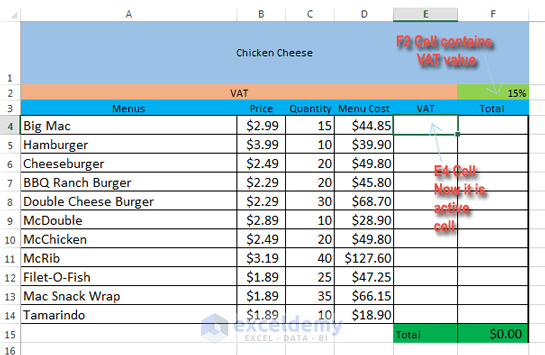

Then for these you want them to move around with it. You want to make sure that if you always want it to be absolute, to be preserved to be this exact cell G2, you want to turn that on in the formula right there. The same concept applies whether the cell is in this table or another table or another sheet. No matter where I paste this it is going to continue to use this absolute cell even though it is using these relative cells. If I look in here I can see there is the dollar sign. So the result is going to be the same here but if I copy and paste you can see how it is using these three but it is still using this one. This is pretty standard spreadsheet stuff going back decades using the dollar sign there. It puts dollar signs in front of both the column and the row to let us know that these are now absolute. So in other words no matter where this formula gets copied and pasted this cell is going to remain exactly at G2. But we'll just set both of them to be absolute. So we don't really care about columns here. We are not moving things around in columns. We can select that and we can select preserve row and or preserve column. You notice there is a little menu arrow there.

We want these to remain relative and this one to be absolute. So we need to switch the reference for this cell from a relative one that would change, to an absolute one that will not change. Down here it is these three and this one which is not what we want. Now notice it has moved all of the references down one because they are all relative. The answer is going to be 86 which would make sense.īut here is what happens if I copy this formula and I paste it.
#Using absolute cell references in excel for mac plus#
The formula now is going to be this plus this plus this times what is in here. In this row we are actually going to put another number. Let's go and add a new row here, I'm going to erase this formula, I'm going to erase all the formulas here. As I move the formula down one row it is going to move all of the references down one row as well. It's all from row 4 now instead of row 3. So in this case you can see it is using these. I can continue doing this as much as I want and it will continue to change. Instead of C2 it is C3 and instead of D2 it is D3. So it increased the row by one for each one of these. I copied and pasted and the cell references changed to reflect the change in position. If I double click on it I can see it is B2 + C2 - D2. So in this case you can see it is showing you right here it is using these three cells to get that number. The great thing is that we can then copy and paste this formula from here to here and it will perform the calculation on a different row. Let's just add this to this and subtract this. Let's populate this table with some sample data and let's just put some random numbers in here and let's go ahead and then perform some calculations based on this. Let's take a look at the difference between Relative and Absolute cell references in formulas. Let's take a look at using Relative and Absolute Cell References in formulas in Numbers. Video Transcript: Hi, this is Gary with. Check out Relative and Absolute Cell References In Numbers at YouTube for closed captioning and more options.


 0 kommentar(er)
0 kommentar(er)
